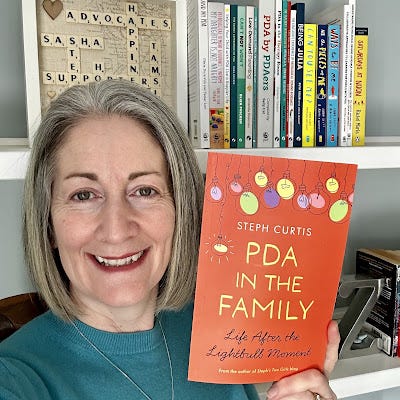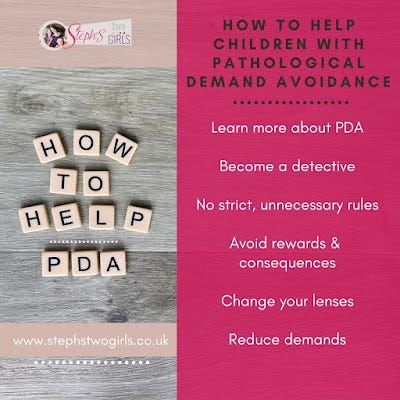Hello again. I’m a little late with this email because PDA Day was yesterday, but my view is that the awareness raising/ accepting/spreading understanding doesn’t need to have a limited timescale. I wrote an update for my blog last night in honour of PDA day and wanted to send this on to anyone who has only started reading my writing recently, and to all those who have been around a little longer, who might want to help with sharing more information about Pathological Demand Avoidance.
Over 14 years ago I typed my first words on my blog website, having plucked the name 'Steph's Two Girls' out of thin air (well, kind of. I did have two girls and I knew I wanted the blog to be about both of them). I barely knew anything about blogging or social media back then, I didn't know much at all about autism, and I hadn't even heard of the words Pathological Demand Avoidance. I was at the beginning of a very steep learning curve!
That day I started blogging was the day when a diagnosis of autism was first suggested for our younger daughter. She was just 2 and a half years old. We had been to an appointment with a paediatrician, after an initial assessment with a speech therapist because Sasha's speech was delayed. There was subsequently a good degree of language catch up, which I mention because, at that time, speech delay with catch up (often by the age of 6) was said to be one of the indicators for PDA (for more information on this, please see the book Understanding Pathological Demand Avoidance Syndrome in Children, page 31).
In the following months, I began to meet with other mums of young autistic girls. And I would think "well, Sasha sounds a bit like those girls, but a lot different in some ways". I couldn't put my finger on what it was exactly, I just knew that Sasha's reactions to many everyday situations were different, and more extreme. Eventually I spent an evening searching the internet for answers, and I came across the term PDD-NOS (more about that in one of my earlier posts here). Pervasive Development Disorder Not Otherwise Specified, sometimes also known as atypical autism, still didn't seem a great fit for our girl, but somehow it felt closer than the more 'general' autism diagnosis.
From there I followed a few leads and eventually ended up on something called the PDA Contact Forum - this went on in the following years to become the national charity for PDA, the PDA Society. Other parents were explaining behaviour and reactions from their children that matched exactly how our young daughter was. That was my Lightbulb Moment. The point at which it all made sense.
And the rest, as they say, is history. History written over 14 years of this blog, sharing our family's experiences. Because I wanted other people to understand that our daughter wasn't being naughty, or oppositional, or awkward. She was just experiencing life differently, and had challenges in different areas to some children.
I knew that traditional, typical parenting methods had worked fine for our older daughter, but that they weren't working for our youngest. There was a lack of understanding from her in some ways, and an inability to see the world from our viewpoint as parents. We soon learned that we were the ones who needed to change our lenses, to alter our behaviour and to widen our knowledge and understanding. 'Telling' our child what to do had little effect. Rewards and consequences had no effect. And underlying a lot of her reactions was an anxiety at an extreme level - although this was harder for most people to see when she was younger.
Several years after that autism diagnosis for our younger daughter we began another learning curve as our older daughter was diagnosed at the age of 16 - first with ADHD, and then with autism. Our two girls are very different from each other; our eldest does not have the PDA profile. Now they are teenagers, soon to be 19 and 17, the blog does not share so much of their personal lives. The stories from now are theirs to tell going forward, if they choose to.
A couple of years ago we were approached to write a book about our PDA experiences and I was happy to do this in order to help other families feel not so alone. I also hoped it would help professionals understand the challenges of PDA. Every time I am asked now what I would like others to know about PDA, I reply "that it is very real".
Our book is called PDA in the Family, released in January 2024.
(My hair colour has changed a little over the past 14 years....!)
PDA in the Family tells our story from that day of diagnosis (and a little bit about the years before) right through the early years, education hurdles, anxiety and mental health, sensory issues and relationships, up until our youngest was about 14 years old. Both girls were fully in agreement with the sharing of these experiences and gave their own words to be shared in the book. There is also a whole chapter written by my husband, the girls' dad, which I think is great because it is rare to hear from a male SEND parent's perspective.
Another result of my blogging that I am proud of is being able to share other people's real-life stories and experiences alongside our own, in two different series - one called Our PDA Story and the other called Not Fine in School. Although situations and ages of children (and adults in some cases) were different in all these stories, there were many similarities and common themes. I recommend checking a variety of these out by clicking on the series name.
The changes and introduction of algorithms on social media mean that these days it is not so easy for posts to be seen; reach is often restricted and I never know who is managing to see anything I write. If you're interested in making sure you do receive more information about PDA from me, please sign up for my Substack email newsletters (stephstwogirls.substack.com). Over 14 years worth of experiences means a lot of posts on the blog so I occasionally try to highlight the ones that I think will be most helpful to other families and professionals in the newsletters.
If you're not sure where to start, here was a good place! You might want to also read my post Ten things you need to know about Pathological Demand Avoidance or to find out what books about PDA I recommend (other than ours ;) ), or maybe you'd like to understand the difference between Pathological Demand Avoidance (PDA) and Oppositional Defiant Disorder (ODD).
Some parents and educators are hoping for strategies or ways to help themselves and their child. Try Strategies for PDA or How to help children with Pathological Demand Avoidance for parents or Pathological Demand Avoidance: Strategies for schools. For a summary of my most read, popular posts, see Top Ten information posts about PDA.
I'd also like to highlight that the PDA Society has a comprehensive website and a free enquiry line, manned by volunteers with a wide range of PDA experience: www.pdasociety.org.uk
Thanks for reading! If you have any questions, please get in touch via stephstwogirls@gmail.com, leave a comment or reply to this email.








Wonderful article. Thanks so much.